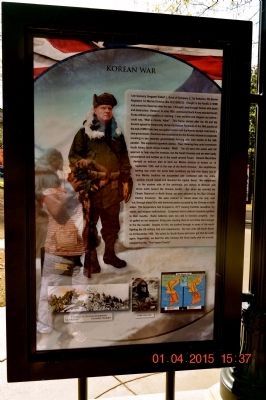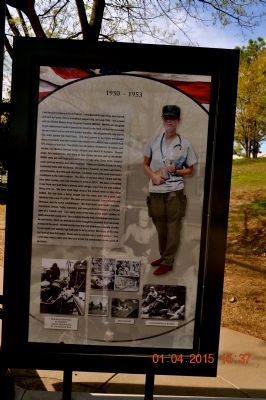Huntsville in Madison County, Alabama — The American South (East South Central)
Korean War/1950-1953
Korean War
I am Gunnery Sergeant Robert L. Koch of Company C, 1st Battalion, 5th Marine Regiment, 1st Marine Division (the OLD BREED). I fought in the Pacific in WWII and joined the Reserves after the war. I thought I was through forever with death and destruction. However, in June 1950, communist North Korea attacked South Korea without provocation or warning. I was recalled and shipped out before I could say, “Wait a minute, folks!” This fracas started after the US and the Soviets agreed to temporarily divide the Korean Peninsula at the 38th parallel at the end of WWII into two occupation zones until the Korean people could elect a new government. Elections were scheduled but the Soviets refused to cooperate resulting in two separate governments forming with their border at the 38th parallel. This separation sparked clashes. Then, thinking they could overwhelm South Korea, North Korea invaded. WAR! The US went into action with UN approval to help stop the invasion, but the South Koreans and we were badly outnumbered and bottled up in the south around Pusan. General MacArthur devised an end-run plan to land our Marine division at Inchon on 15 September 1950, well to the rear of the North Koreans. Our amphibious landing was under the worst tidal conditions we had ever faced, but in true Marine tradition we succeeded and combined with the Army, quickly moved inland and liberated the capital, Seoul. We redeployed to the eastern side of the peninsula, put ashore at Wonsan and drove north toward the Chinese border. But when we reached the Chosin Reservoir in North Korea, we were attacked by ten Red Chinese Infantry divisions! We were ordered to retreat down the only road out, through steep hills with dominant peaks occupied by the Chinese on both sides! The temperature had dropped to -35°F causing frostbite casualties, icy roads, and weapons malfunctions. Corpsmen had to defrost morphine syrettes in their mouths. Radio batteries were too cold to function properly. Gun oil gelled on our weapons’ firing pins causing them to not strike hard enough to fire the rounds! Despite all this, we pushed through in some of the worst fighting the US military had ever experienced. Our last units left North Korea on 24 December 1950. We sailed for South Korea and never got that far north again. Regardless, we beat the elite Chinese 9th Army badly and we proudly claimed the title, “The Frozen Chosin!”
(side 2)
1950-1953
I am Second Lieutenant Diana Palmer. I volunteered for the Army, was trained, and sent to Pusan, Korea, a southern seaport city, on 6 July 1950. I am a nurse with the 8055th Mobile Army Surgical Hospital (MASH). MASHs are designed to get experienced medical personnel closer to the front, so that the wounded can be treated sooner and with greater success. We are generally only four to five miles behind the front lines. This has proved to be highly successful since a seriously wounded soldier who makes it to a MASH has a greater than 97% chance of survival. The 8055th has 30 medics, 10 doctors, 10 nurses, one dentist, two Medical Service Corps officers, and about 30 Koreans. Several jeeps, two ambulances, and three or four trucks are also part of the MASH. MASH units are well organized and have a triage area, X-ray room, surgical room, post-op section, and other facilities. These are usually housed in long, connected tents with dirt floors. On occasion, however, we have used barns, schoolhouses, rice mills and churches. Certainly, one of the most unpleasant conditions is the cold winter. The stove in my tent, which I share with the nine other nurses, uses fuel oil which is solid at -20°F! We have a minefield in our front yard and there is always some danger, even from our own artillery firing over us. We have sand bags around the patient tents to stop stray bullets, but one time a bullet zinged into the mess tent, hit a post, and splashed into a cup of coffee! We clean and close wounds, treat fractures and illnesses, and do some rehabilitation. We treat North and South Koreans, Americans, British, Turks, reporters, and even performed surgery on the pet deer of a Turkish unit. I am upset most of the time at the sheer number of badly wounded young men. Our chaplain literally had a breakdown and had to be sent home. Once, an ambulance driver brought in wounded from the south instead of the north. He told me the front line had withdrawn a couple of miles to our south and nobody had bothered to let us know! Not funny at the time, but later we saw the humor. Some want to call this war a "police action". If so, I wish they would come over here and arrest the communists so we could all go home!
Topics. This memorial is listed in this topic list: War, Korean. A significant historical month for this entry is June 1950.
Location. 34° 44.108′ N, 86° 35.324′ W. Marker is in Huntsville, Alabama, in Madison County. Memorial can be reached from the intersection of Monroe Street Northwest and Jefferson Street North, on the left when traveling east. Veterans Memorial Park along the Patriots Walkway near the five points ditch. Touch for map. Marker is at or near this postal address: 200 Monroe Street Northwest, Huntsville AL 35801, United States of America. Touch for directions.
Other nearby markers. At least 8 other markers are within walking distance of this marker. 1959-1975/Vietnam War/Vietnam War (here, next to this marker); Cold War-Global 1945-/ Cold War-Germany 1945-1990 (here, next to this marker); Gulf War-1991/War on Terrorism (here, next to this marker); Korean War / Cold War-Korea 1953- (here, next to this marker); World War II - European Theater of Operations (ETO) (here, next to this marker); ETO 1939-1945/PTO 1941-1945 (here, next to this marker); World War II - Pacific Theater of Operations (PTO) (a few steps from this marker); Spanish American War 1898/Philippine Insurrection 1899-1913 (a few steps from this marker). Touch for a list and map of all markers in Huntsville.
Also see . . . Huntsville Madison County Veterans Memorial. (Submitted on April 17, 2015.)
Credits. This page was last revised on June 16, 2016. It was originally submitted on April 16, 2015, by Sandra Hughes Tidwell of Killen, Alabama, USA. This page has been viewed 513 times since then and 21 times this year. Last updated on July 15, 2015, by J. Makali Bruton of Accra, Ghana. Photos: 1, 2. submitted on April 16, 2015, by Sandra Hughes Tidwell of Killen, Alabama, USA. • Bill Pfingsten was the editor who published this page.

